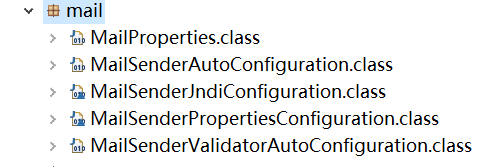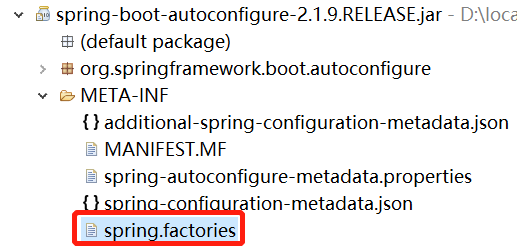對照談-官方spring-boot-starter和自定義starter異同分析
在前面我講用spring-boot-starter-mail發郵件的時候,我側重看的是spring boot發郵件的便利性,今天,我們聊下另外一個方面,spring-boot-starter自身的結構。
1、看看官方starter的jar裡面都有啥
之前使用starter的時候,都是用了就完事了,這次發郵件的時候,好奇心上來了,點開了spring-boot-starter-mail的jar包內容,發現竟然只有一個MANIFEST.MF檔案,沒有class檔案,沒有配置檔案,非常的簡單。

我們看下這個MANIFEST.MF裡面都有些啥
Manifest-Version: 1.0
Implementation-Title: Spring Boot Mail Starter
Automatic-Module-Name: spring.boot.starter.mail
Implementation-Version: 2.1.8.RELEASE
Built-By: Spring
Build-Jdk-Spec: 1.8
Created-By: Maven Archiver 3.4.0這個也非常的普通,比平平無奇的古天樂還要平平無奇,這不科學啊。如果只憑這個檔案就能發郵件,那我早就靠收藏寫真圖片娶到新垣結衣了。肯定程式碼在別的地方,在找程式碼前,我們先動手自己製作一個starter。
2、突然要開始自己寫個starter
自己寫個starter也很簡單,我們先從https://start.spring.io/下載一個基本的專案結構下來,然後需要修改幾個地方。
首先是pom檔案要修改,我的pom檔案是這樣的
<?xml version="1.0" encoding="UTF-8"?> <project xmlns="http://maven.apache.org/POM/4.0.0" xmlns:xsi="http://www.w3.org/2001/XMLSchema-instance" xsi:schemaLocation="http://maven.apache.org/POM/4.0.0 https://maven.apache.org/xsd/maven-4.0.0.xsd"> <modelVersion>4.0.0</modelVersion> <groupId>com.skyblue</groupId> <artifactId>mystarter-spring-boot-starter</artifactId> <version>1.0</version> <name>mystarter</name> <description>spring boot starter demo</description> <properties> <java.version>1.8</java.version> </properties> <dependencyManagement> <dependencies> <dependency> <groupId>org.springframework.boot</groupId> <artifactId>spring-boot-dependencies</artifactId> <version>2.1.9.RELEASE</version> <type>pom</type> <scope>import</scope> </dependency> </dependencies> </dependencyManagement> <dependencies> <dependency> <groupId>org.springframework.boot</groupId> <artifactId>spring-boot-autoconfigure</artifactId> <scope>compile</scope> </dependency> <dependency> <groupId>org.projectlombok</groupId> <artifactId>lombok</artifactId> <version>1.18.6</version> <optional>true</optional> <scope>provided</scope> </dependency> <dependency> <groupId>org.springframework.boot</groupId> <artifactId>spring-boot-starter-test</artifactId> <scope>test</scope> </dependency> </dependencies> <build> <plugins> <plugin> <groupId>org.springframework.boot</groupId> <artifactId>spring-boot-maven-plugin</artifactId> </plugin> </plugins> </build> </project>
比起原始的pom.xml,改動了這麼幾個地方。
<artifactId>mystarter-spring-boot-starter</artifactId>spring 官方的推薦寫artifactId的方法是這樣
- 官方命名格式為: spring-boot-starter-{name}
- 非官方建議命名格式:{name}-spring-boot-starter
所以,官方用來發mail的starter是spring-boot-starter-mail,我這邊用的就是mystarter-spring-boot-starter。
原始pom.xml會有這一段,是需要去掉的,否則打包的時候自己寫的類加不進去,jar裡面都是spring boot的類
<parent>
<groupId>org.springframework.boot</groupId>
<artifactId>spring-boot-starter-parent</artifactId>
<version>2.1.9.RELEASE</version>
<relativePath /> <!-- lookup parent from repository -->
</parent>另外需要加至少兩個依賴進去
<dependencyManagement>
<dependencies>
<dependency>
<groupId>org.springframework.boot</groupId>
<artifactId>spring-boot-dependencies</artifactId>
<version>2.1.9.RELEASE</version>
<type>pom</type>
<scope>import</scope>
</dependency>
</dependencies>
</dependencyManagement>
<dependencies>
<dependency>
<groupId>org.springframework.boot</groupId>
<artifactId>spring-boot-autoconfigure</artifactId>
<scope>compile</scope>
</dependency>
</dependencies>其實把兩個依賴都放在<dependencies>節點裡面也行,<dependencyManagement>和<dependencies>的區別請自行搜尋。
pom.xml改好了後我們需要為自己的starter寫class啦,我們這邊為了演示,就只實現列印兩個值的功能,看程式碼
public interface MyStarterService {
String getMessage();
Integer getCode();
}
public class MyStarterServiceImpl implements MyStarterService{
@Autowired
private MyStarterProperties myStarterProperties;
public String getMessage() {
return myStarterProperties.getMessage();
}
public Integer getCode() {
return myStarterProperties.getCode();
}
}這個介面和實現類就是簡單的返回屬性值而已,屬性值的配置檔案是這樣的
@ConfigurationProperties(prefix = "mystarter")
public class MyStarterProperties {
String message;
int code;
public String getMessage() {
return message;
}
public void setMessage(String message) {
this.message = message;
}
public int getCode() {
return code;
}
public void setCode(int code) {
this.code = code;
}
}@ConfigurationProperties註解表示MyStarterProperties 裡面的引數message和code都會從配置檔案裡面讀取,prefix = "mystarter"表示配置檔案裡面引數名稱是有字首的,字首就是mystarter。舉個具體的例子,比如我們之前發郵件的引數也是配置在application.properties,引數的內容是這樣的
spring.mail.host=smtp.163.com
spring.mail.port=25
[email protected]
spring.mail.password=yourpassword裡面host,port,username,password就是引數的名稱,spring.mail就是字首。
上面這些寫好了相當於業務功能部分,現在需要把業務功能申明到spring-boot-starter體系裡面去,需要靠下面這個類
@Configuration
//告訴spring容器配置檔案讀取用MyStarterProperties.class
@EnableConfigurationProperties({MyStarterProperties.class})
//匯入業務元件MyStarterServiceImpl
@Import(MyStarterServiceImpl.class)
public class MyStarterAutoConfiguration {
}我用的是最簡單的方式,其實spring boot還提供了@Conditional 系列註解實現更加精確的配置載入Bean的條件,這裡就不詳述了。
最後,我們需要告訴spring boot在哪裡去找到這個MyStarterAutoConfiguration ,在resources/META-INF下面建一個spring.factories檔案

內容也很簡單,就一句而已
org.springframework.boot.autoconfigure.EnableAutoConfiguration=\
com.skyblue.mystarter.MyStarterAutoConfiguration這樣,其實一個自定義的starter就完成了,用mvn install就可以直接生成一個starter了。
3、回頭看spring-boot-starter-mail真正的實現程式碼
在給starter取名字的時候說了,官方命名格式是有固定格式的。其實官方的便利可不在名字上,而是程式碼都包含在spring boot的jar裡面,我們引入spring boot的依賴時,會自動載入spring-boot-autoconfigure.xxx.jar,開啟這個jar,就可以看到mail的真正程式碼了

有沒有一種很熟悉的感覺,MailProperties和上面的MyStarterProperties,MailSenderAutoConfiguration和上面的MyStarterAutoConfiguration,顯然都是一樣按照spring boot starter的規則寫的,只是這個官方starter的程式碼不放在starter的jar包,而是包裝到了spring-boot-autoconfigure的jar裡面,我們看下MailSenderAutoConfiguration的原始碼,可以看到它就用到了@Configuration、@EnableConfigurationProperties、@Import,還用到了我們沒用到的@Conditional註解
@Configuration
@ConditionalOnClass({ MimeMessage.class, MimeType.class, MailSender.class })
@ConditionalOnMissingBean(MailSender.class)
@Conditional(MailSenderCondition.class)
@EnableConfigurationProperties(MailProperties.class)
@Import({ MailSenderJndiConfiguration.class, MailSenderPropertiesConfiguration.class })
public class MailSenderAutoConfiguration {
/**
* Condition to trigger the creation of a {@link MailSender}. This kicks in if either
* the host or jndi name property is set.
*/
static class MailSenderCondition extends AnyNestedCondition {
MailSenderCondition() {
super(ConfigurationPhase.PARSE_CONFIGURATION);
}
@ConditionalOnProperty(prefix = "spring.mail", name = "host")
static class HostProperty {
}
@ConditionalOnProperty(prefix = "spring.mail", name = "jndi-name")
static class JndiNameProperty {
}
}
}
還有一個spring.factories檔案,也可以在spring-boot-autoconfigure.jar裡面找到

在裡面,我們可以看到完整的spring boot官方starter的AutoConfiguration類列表
# Auto Configure
org.springframework.boot.autoconfigure.EnableAutoConfiguration=\
org.springframework.boot.autoconfigure.admin.SpringApplicationAdminJmxAutoConfiguration,\
org.springframework.boot.autoconfigure.aop.AopAutoConfiguration,\
org.springframework.boot.autoconfigure.amqp.RabbitAutoConfiguration,\
org.springframework.boot.autoconfigure.batch.BatchAutoConfiguration,\
org.springframework.boot.autoconfigure.cache.CacheAutoConfiguration,\
org.springframework.boot.autoconfigure.cassandra.CassandraAutoConfiguration,\
org.springframework.boot.autoconfigure.cloud.CloudServiceConnectorsAutoConfiguration,\
......我這邊就不全列出來了,大家根據這個去找需要的官方starter就比較方便了。
4、猛回頭我們呼叫下我們的自定義starter
我們另外用https://start.spring.io/再建立一個專案,然後在pom.xml裡面載入starter的依賴
<dependency>
<groupId>com.skyblue</groupId>
<artifactId>mystart</artifactId>
<version>1.0</version>
<type>jar</type>
<scope>system</scope>
<systemPath>D:\\workspace\\mystart\\target\\mystarter-spring-boot-starter-1.0.jar</systemPath>
</dependency>我為了圖方便,就直接用pom.xml呼叫了本地打包的starter包,如果有maven的私服,就可以正常引入。配置application.properties檔案
mystarter.message=hello world!
mystarter.code=42寫一個呼叫starter的類
@Service
public class TestService {
@Resource
private MyStarterService myStarterService;
public void message() {
System.out.println("code:" + myStarterService.getCode());
System.out.println("message:" + myStarterService.getMessage());
}
}啟動spring boot 檢視結果
@SpringBootApplication
public class StartdemoApplication {
public static void main(String[] args) {
ApplicationContext context = SpringApplication.run(StartdemoApplication.class, args);
((TestService)context.getBean("testService")).message();
}
}console可以看到打印出來的message和code
. ____ _ __ _ _
/\\ / ___'_ __ _ _(_)_ __ __ _ \ \ \ \
( ( )\___ | '_ | '_| | '_ \/ _` | \ \ \ \
\\/ ___)| |_)| | | | | || (_| | ) ) ) )
' |____| .__|_| |_|_| |_\__, | / / / /
=========|_|==============|___/=/_/_/_/
:: Spring Boot :: (v2.1.9.RELEASE)
2019-10-10 22:13:49.521 INFO 21952 --- [ main] c.w.startdemo.StartdemoApplication : Starting StartdemoApplication on skyblue with PID 21952 (D:\workspace\startdemo\target\classes started by wphmo in D:\workspace\startdemo)
2019-10-10 22:13:49.527 INFO 21952 --- [ main] c.w.startdemo.StartdemoApplication : No active profile set, falling back to default profiles: default
2019-10-10 22:13:50.405 INFO 21952 --- [ main] c.w.startdemo.StartdemoApplication : Started StartdemoApplication in 1.353 seconds (JVM running for 1.983)
code:42
message:hello world!這樣,一個完整的自定義starter就執行成功了。
